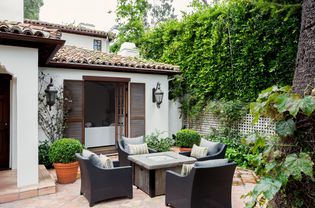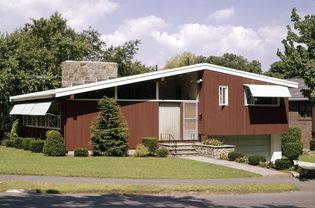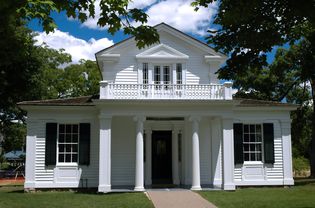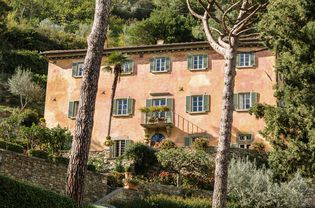Colonial-Revival style homes have shaped the history of American architecture and its iconic details can be found in more architectural designs than you may realize. Originating as a spinoff from Colonial architecture, Colonial-Revival is one of the most enduring styles in American architecture.
Origins of Colonial-Revival Style
As suggested by its name, Colonial-Revival owes its existence to an earlier era of American architecture in the colonial period. Colonial architecture in America was heavily influenced by British, Dutch, Spanish, and French designs, but without a measure of the luxury and opulence these styles possessed in the homes of nobility across Europe and the British empire. Instead, American colonial homes focused on designs that were more simple, symmetrical, and practical for easy development.
Colonial-Revival entered the architectural scene of America at the turn of the 20th century, spurred on by the 1876 Centennial Exposition, which celebrated 100 years since the signing of the Declaration of Independence. For the first time in the country’s history, an increasing importance was being placed on documenting and preserving buildings of architectural interest.
However, the Colonial-Revival style wasn’t a strict interpretation of colonial-era homes. Changes to the average American lifestyle, along with advances in technology and increased access to building materials, meant that architects and builders could take more liberties when building a new colonial-style home. As an example, during the early 1900s, it was common to marry Colonial styles with ornate Victorian-era designs. The simple, symmetrical colonial style was rebooted, dressed in fancy details and ornate work, and outfitted with new technology unavailable at the time of original Colonial style homes.
Colonial-Revival homes peaked in the 1940s, tapering off in popularity after World War II. However, most would agree that the style is one of the most enduring examples of American architecture. Throughout the decades, Colonial-Revival homes have continued to offer a tried-and-true traditional approach to home construction. Subdivisions across the country are dotted with interpretations of the Colonial-Revival style.
:max_bytes(150000):strip_icc()/GettyImages-182688943-2f39bc5a32c1475c967bf81a4316bde3.jpg)
jhorrocks / Getty Images
Key Characteristics of Colonial-Revival Homes
This style is known for its mix of elements and its broad options. Key Colonial features such as simple layouts, symmetrical window designs, and gabled roofs are combined with ornate Victorian features, such as intricate detailing, porticos, moldings, and large windows. In summary, Colonial-Revival style homes mix the simple symmetry and structure of the colonial style with the fanciful taste of Victorian-era architecture.
Front-gabled or side-gabled roofs, hip roofs, and gambrel roofs are all seen in this style, emphasizing the diversity of inspiration springing from early English, French, Spanish, and Dutch colonial design. The varying rooflines give this style a wide variety of expressions. Two-story colonial-revival homes are most common, but this is not a defining feature. A popular sub-type of this architectural style is the typically one-floor Cape Cod home.
Windows are multi-paned and are often decorated with shutters or pediments, as are the doors. Unlike simple Colonial designs, these shutters and pediments are often fancifully decorated with cutout designs or carvings. Small porticos and pillars are seen at entrances, and ornate moldings and detail work dress up the simplicity of the original Colonial-style home.
Interiors are made up of distinctly divided rooms and often feature a central staircase similar to Colonial designs. The style lends itself to a traditional interior design.
American Colonial vs. Colonial-Revival
American Colonial and Colonial-Revival architecture share the same roots, so it's no surprise to see similarities between the styles. Homes built in either style tend to have a rectangular footprint and a traditional approach to design. At the same time, Colonial-Revival introduces elements and features not seen in the more plain American Colonial style.
Large windows, often in pairs
Grand entryway with showier portico or pediment. May include columns
Intricate details and fanciful designs, such as on moldings or shutters
Fireplaces with swags
Brick often used on the exterior
Small windows
Centered entryway with small portico or pediment
Central fireplace and staircase
Rectangular in shape
Clapboard or shingles often used on the exterior
:max_bytes(150000):strip_icc()/GettyImages-182841944-d843a02f2fb042d785310cfd3e3afb65.jpg)
lillisphotography / Getty Images
:max_bytes(150000):strip_icc()/historic-colonial-style-house-news-photo-883515418-1539018922-30380b064df945f19bc557da61351f75.jpeg)
John Greim / Getty Images
The Presence of Colonial-Revival Homes Today
Though this style was most ubiquitous in the 1940s, it continues to inspire architects to this day. Both private and public-sector buildings, including schools, libraries, and governmental buildings make the most of this traditional design style.
With a mix of multiple time eras and a nod to American history, this style continues to have a firm hold on American architecture. Newer construction homes in suburban neighborhoods are often referred to as ‘Neo-Colonial,’ a style that updates and simplifies Colonial-Revival features for the modern world. While the inspiration for Colonial-Revival homes was borrowed from British, French, Dutch, and Spanish architecture, the style has become uniquely American and has stood the test of time.
:max_bytes(150000):strip_icc()/Erica-Puisis-c39951085ba54f3db917710a5ec48084.jpg)
:max_bytes(150000):strip_icc()/_DSC3035-89e8764848db4aa6901d9451b9b15923.jpeg)
:max_bytes(150000):strip_icc()/BrickColonialRevivalHome-efb6e7b7405048a4862f0cd1d1e63151.jpg)




